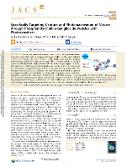Specifically Targeting Capture and Photoinactivation of Viruses through Phosphatidylcholine-Ganglioside Vesicles with Photosensitizer

Datum vydání
2024Publikováno v
JACS AuRočník / Číslo vydání
4 (8)ISBN / ISSN
ISSN: 2691-3704ISBN / ISSN
eISSN: 2691-3704Metadata
Zobrazit celý záznamKolekce
Tato publikace má vydavatelskou verzi s DOI 10.1021/jacsau.4c00453
Abstrakt
Herein, we performed a simple virus capture and photoinactivation procedure using visible light on phosphatidylcholine vesicles. L-α-Phosphatidylcholine vesicles were enriched by viral receptors, GT1b gangliosides, and the nonpolar photosensitizer 5,10,15,20-tetraphenylporphyrin. These vesicles absorb in the blue region of visible light with a high quantum yield of antiviral singlet oxygen, O2 (1Δg). Through the successful incorporation of gangliosides into the structure of vesicles and the encapsulation of photosensitizers in their photoactive and monomeric state, the photogeneration of O2(1Δg) was achieved with high efficiency on demand; this process was triggered by light, and specifically targeting/inactivating viruses were captured on ganglioside receptors due to the short lifetime (3.3 μs) and diffusion pathway (approximately 100 nm) of O2(1Δg). Time-resolved and steady-state luminescence as well as absorption spectroscopy were used to monitor the photoactivity of the photosensitizer and the photogeneration of O2(1Δg) on the surface of the vesicles. The capture of model mouse polyomavirus and its inactivation were achieved using immunofluorescence methods, and loss of infectivity toward mouse fibroblast 3T6 cells was detected.
Klíčová slova
singlet oxygen, photosensitizer, photodynamic, gangliosides, polyomavirus, photoinactivation
Trvalý odkaz
https://hdl.handle.net/20.500.14178/2613Licence
Licence pro užití plného textu výsledku: Creative Commons Uveďte původ 4.0 International







